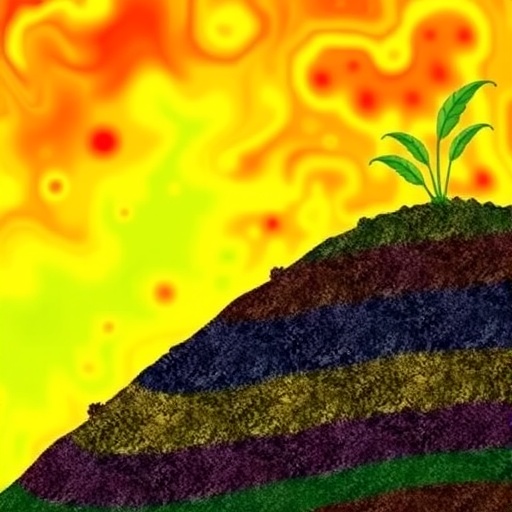In the ever-evolving field of environmental science, the intricate relationship between soil health and land usage continues to garner significant attention. Recent research conducted by a team led by Fabijańczyk, Zawadzki, and Magiera dives deep into this relationship, focusing specifically on magnetic susceptibility as a reliable indicator of soil contamination. Their findings, published in Environ Sci Pollut Res, offer critical insights into how different patterns of land use influence soil contamination levels. Through the innovative application of cross-variogram analysis, the study stands as a testament to the potential of non-traditional methods in environmental monitoring.
Magnetic susceptibility, which reflects a soil’s ability to become magnetized in response to an external magnetic field, has emerged as a valuable tool for assessing contamination. The study meticulously compares agricultural lands, urban areas, and industrial sites, seeking to comprehend how these contrasting land uses affect magnetic properties. By employing comprehensive sampling and analysis techniques, the researchers not only enrich our understanding of contamination pathways but also pave the way for innovative soil remediation strategies.
The methodology adopted in this study is particularly noteworthy. Cross-variogram analysis serves as the backbone of their assessment, allowing researchers to investigate the spatial distribution of soil properties. This statistical method captures the degree of scientific variation in magnetic susceptibility across diverse land use settings. By highlighting spatial patterns, the researchers aim to identify hotspots of contamination, which can be critical for targeted remediation efforts.
Their findings revealed that urban soils demonstrated significantly higher magnetic susceptibility compared to rural agricultural lands. Such results underscore the impact of human activities—such as construction, vehicular emissions, and waste disposal—on soil quality. The data also indicates that industrial areas exhibited extreme fluctuations in magnetic susceptibility, suggesting a concentrated presence of contaminants that merit closer examination. This variability hints at the wide-ranging effects of industrial practices on the surrounding environment.
The implications of this research extend far beyond academic curiosity. Understanding the role of magnetic susceptibility as a contamination proxy holds significant practical utility. Farmers and urban planners can leverage this knowledge to implement sustainable practices and evaluate land use strategies. Soil contamination, influenced by various anthropogenic factors, poses risks not only to agricultural productivity but also to public health and ecosystem integrity.
Moreover, the study advocates for the broader application of magnetic susceptibility assessments in environmental monitoring programs. Traditional soil testing methods, while effective, can be costly and time-consuming. The use of magnetic susceptibility as a low-cost, rapid assessment tool could facilitate the timely identification of contaminated sites, thereby accelerating remediation efforts. The research team envisions a future where this innovative tool complements existing methodologies, providing a holistic view of soil health.
In addition to its practical implications, the research also raises important questions regarding the long-term effects of land use changes on soil ecosystems. With increasing urbanization and industrialization, understanding these effects becomes crucial for future land management. Continued exploration of magnetic susceptibility may reveal trends that inform policies aimed at curbing soil degradation—a pressing concern in an era marked by environmental crises.
The research also emphasizes the necessity for interdisciplinary collaboration. Environmental scientists, geologists, urban planners, and policymakers must work together to translate these findings into actionable strategies. Initiatives focused on sustainable land management practices could significantly mitigate soil contamination while fostering community awareness regarding the health of local ecosystems.
This study showcases the importance of integrating new techniques into environmental research. Magnetic susceptibility analysis, as highlighted by the researchers, reinforces the notion that innovative methods can profoundly enhance our understanding of soil dynamics. As the field progresses, it is crucial to continue exploring integrative approaches that bridge traditional scientific inquiry with emerging technologies.
Moreover, engaging the public in these conversations is essential. Raising awareness about soil contamination and its implications fosters a sense of responsibility among communities and encourages proactive measures. Education-focused initiatives can empower individuals to make informed choices about land use and agricultural practices, ultimately contributing to healthier ecosystems.
In conclusion, the work of Fabijańczyk and colleagues exemplifies a pioneering spirit in environmental research. Their exploration of magnetic susceptibility as a proxy for soil contamination not only enriches academic discourse but also serves as a catalyst for practical innovations. The potential for rapid, cost-effective soil assessments holds promise for future research and environmental policy, generating a ripple effect that could benefit both local and global ecosystems for generations to come.
In a world facing unprecedented environmental challenges, such studies are critical for understanding the intricate web of interactions between human activity and the natural world. The findings ultimately call for a concerted effort to address soil contamination, emphasizing the need for collaborative, innovative solutions to protect our planet’s health.
Understanding the nuances of soil quality is paramount for sustaining agricultural land, ensuring that future generations inherit a vibrant, productive, and healthy environment. As we continue to uncover the complexities of environmental science, this research stands as a beacon of hope—highlighting the progressive steps being taken toward a more sustainable future.
In summary, the work titled “Magnetic susceptibility as a proxy for soil contamination: cross-variogram analysis across contrasting land use areas” contributes significantly to our understanding of soil contamination and its ties to land use. This study, grounded in robust scientific methodology, paves the way for future innovations that balance ecological integrity with human development.
Subject of Research: The impact of land use on soil contamination as assessed by magnetic susceptibility.
Article Title: Magnetic susceptibility as a proxy for soil contamination: cross-variogram analysis across contrasting land use areas.
Article References: Fabijańczyk, P., Zawadzki, J. & Magiera, T. Magnetic susceptibility as a proxy for soil contamination: cross-variogram analysis across contrasting land use areas. Environ Sci Pollut Res (2025). https://doi.org/10.1007/s11356-025-37158-w
Image Credits: AI Generated
DOI: https://doi.org/10.1007/s11356-025-37158-w
Keywords: soil contamination, magnetic susceptibility, land use, environmental science, cross-variogram analysis.




